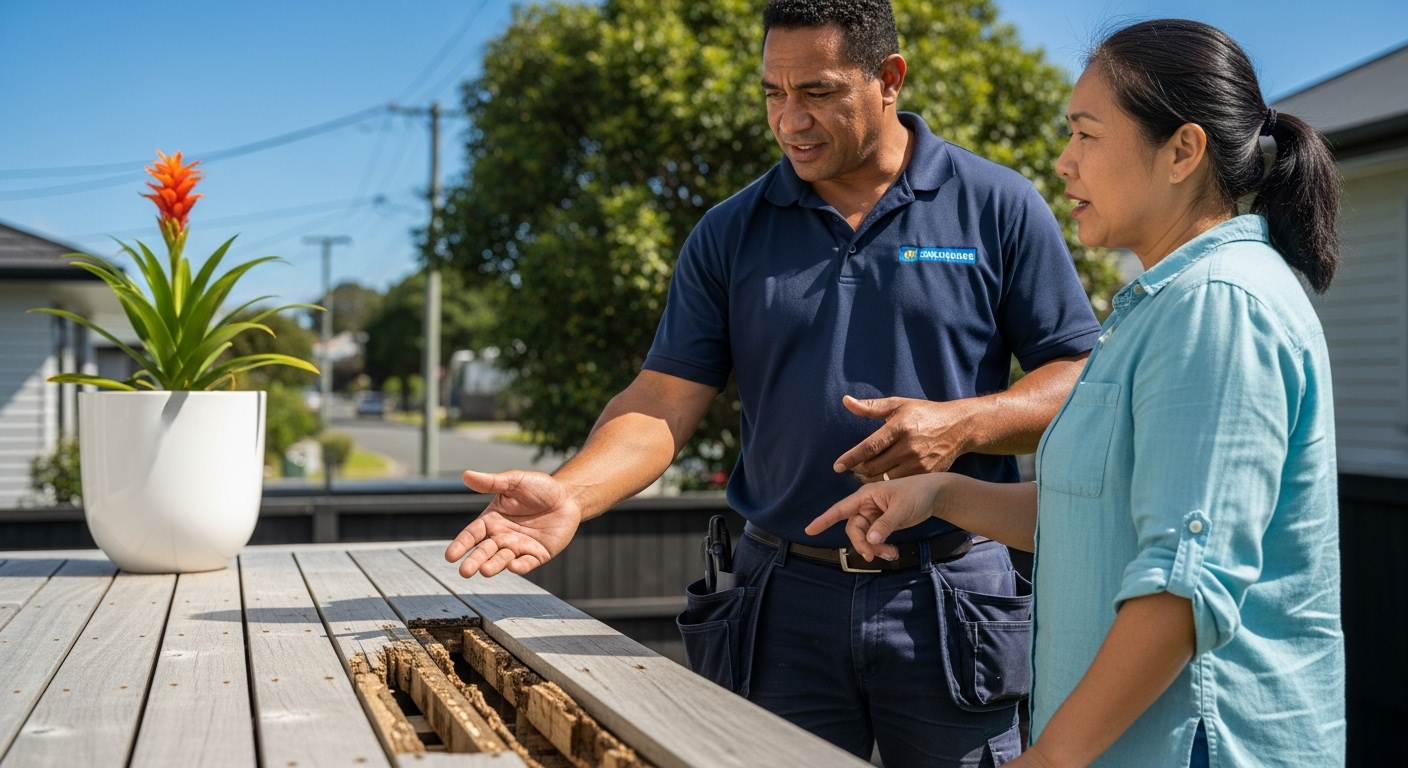The Auckland Deck Care Handbook: A Seasonal Guide to Maintenance & Repairs
Your Essential Seasonal Deck Maintenance Guide
Key Takeaways
- Auckland's humid climate and strong UV rays demand a specific, seasonal approach to deck care to prevent damage.
- Regular cleaning and inspection are crucial for preventing common issues like rot, mould, and structural weakness.
- The type of decking material you have, whether timber or composite, significantly changes your maintenance routine and long-term costs.
- Knowing the early warning signs of deck deterioration can save you from more expensive repairs down the line.
A beautiful deck is more than just an addition to your home; it’s the heart of your outdoor living space, the stage for countless summer barbecues, family gatherings, and quiet morning coffees. For any Auckland homeowner, it's a significant investment that enhances both your lifestyle and your property's value. But our unique climate, with its high humidity and powerful sun, can be tough on outdoor structures.
Without the right care, timber can start to warp, rot can set in, and what was once your pride and joy can become a safety concern. That's why we've put together this comprehensive seasonal guide. Think of it as your go-to handbook for protecting your investment, helping you proactively care for your deck so it remains a safe and stunning space for years to come.
A Seasonal Checklist for Your Auckland Deck
A little bit of maintenance each season goes a long way. By aligning your deck care with the calendar, you can stay ahead of potential problems and keep your outdoor area in top shape all year long.
Spring: The Annual Inspection and Clean
As the weather warms up, it’s the perfect time to give your deck a thorough check-up after the wet winter months. Start by clearing away any furniture and pots. Give the entire surface a good sweep, then inspect it for any signs of damage. Look for popped nails, loose boards, or any areas showing signs of mould or mildew. A gentle wash with a deck cleaning solution will get it looking fresh and ready for the sunny days ahead.
Summer: Sun and UV Protection
Auckland's summer sun is intense, and its UV rays can cause timber decks to fade, dry out, and splinter. If you have a timber deck, summer is the time to ensure it’s protected. This might mean applying a fresh coat of stain or oil to shield the wood from sun damage. For all deck types, keeping the surface clear of dirt and debris will help prevent scratches and allow it to dry quickly after those unpredictable summer showers.
Autumn: Prepare for the Wet
Falling leaves might look lovely, but when they accumulate on your deck, they trap moisture and create a breeding ground for mould and rot. Make a habit of sweeping your deck regularly throughout autumn. Before winter truly sets in, give it one last deep clean to remove any built-up grime, ensuring it’s in the best possible condition to face the wetter months.
Winter: Focus on Drainage and Airflow
Winter is all about managing moisture. Ensure that your deck has proper drainage and that nothing is blocking water from flowing away. If possible, move heavy pot plants or furniture that sit flat on the surface, as they can trap water underneath and lead to discolouration or rot. A little bit of airflow can make a huge difference.
Caring for Different Decking Materials
Not all decks are created equal, and your maintenance plan will depend heavily on the material you have. Understanding the specific needs of your deck is the first step toward effective care.
Timber Deck Maintenance (Pine & Hardwood)
Traditional timber decks have a natural beauty that is hard to beat, but they require the most upkeep. To keep a timber deck looking its best and protected from the elements, you’ll need to clean it annually and re-apply a protective coating of oil or stain every 1-2 years. This is especially important in Auckland to prevent moisture absorption and sun damage. For those seeking a durable and beautiful timber option, we often recommend quality hardwood decking. The Vitex and Kwila we use are not only known for their longevity but are also sourced from sustainable, managed forests, making them an eco-friendly choice.
Composite Deck Maintenance
If "low maintenance" is your mantra, then composite decking is your friend. As one source notes, composite decking is made from a blend of recycled wood fibers and plastics , which makes it highly resistant to the rot, mould, and UV damage that can plague timber decks. It doesn't require the regular staining or sealing that wood does. A simple wash with soap and water is usually all it takes to keep it looking great. Our high-quality, low-maintenance composite decking goes a step further by using hidden fixings, which creates a sleek, clean finish with no exposed screws—a safer option for bare feet, kids, and pets.

Spotting Common Deck Problems Early
Regular inspections are your best defence against costly repairs. Knowing what to look for can help you catch small issues before they become major headaches. According to industry experts, there are several obvious signs that a deck may need attention. Be on the lookout for:
- Loose or Damaged Boards: Check for boards that move underfoot, are splintering, or have visible cracks.
- Rot or Mould Growth: Pay close attention to areas that stay damp. Use a screwdriver to gently poke any suspect spots; if the wood is soft and spongy, you have rot.
- Wobbly Handrails: Handrails are a critical safety feature. If they feel loose or unstable, they need to be secured immediately.
- Structural Issues: Look at the support posts and beams. Any signs of rot, cracking, or separation from the house are serious red flags.

DIY Fix vs. Calling the Professionals: When to Make the Call?
So, you’ve found a problem. Can you fix it yourself? Some minor tasks like cleaning, sanding a small patch, or tightening a loose screw are well within the capabilities of a handy homeowner. However, it's crucial to know your limits.
You should always call a professional for deck repairs involving structural components, significant rot, or the replacement of multiple boards. Attempting these jobs without the right experience can lead to improper fixes that compromise the safety of your deck. It can also end up costing you more in the long run. While costs can vary, delaying professional help for what seems like a small issue can lead to much bigger problems. Data on deck repairs in New Zealand shows that while a minor fix might be around $150, the typical cost for more substantial work ranges from $750 to $3,200, and can even climb as high as $6,670 for extensive damage. Getting an expert in early ensures the job is done right and your deck remains safe for everyone.
Considering Your Investment: Upfront vs. Long-Term Costs
When thinking about a new deck or replacing an old one, it's helpful to consider the full picture. The initial cost is only one part of the equation. As one detailed breakdown shows, the average cost of decking in New Zealand can range from $300 to $1,000 per square metre. A standard pine deck might be the most affordable option upfront, typically sitting at $300-$400 per square metre. In contrast, composite decking is a larger initial investment at around $500-$700 per square metre. However, when you factor in the ongoing costs of staining, sealing, and potential repairs for a timber deck, a low-maintenance composite option often proves more cost-effective over its lifespan.
Your deck is a valuable part of your home, and with a little seasonal attention, it will provide enjoyment for many years. By following this guide, you can confidently protect your investment and keep your outdoor space looking its best. If you spot a problem you're not sure how to handle, or if you're considering an upgrade, don't hesitate to reach out. We're always here to help with expert advice and quality workmanship.
_Disclaimer: The information provided in this article is for general guidance only. Deck construction and repair can involve serious safety risks. Always consult with a qualified and licensed professional for any structural work or repairs you are not comfortable performing yourself. Ensure all work complies with local building codes and regulations._

